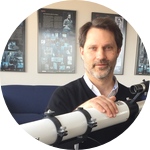Project Results
The initial 16 simulations have been completed on a standard 100 cc optical pumping cell. I found an unexpected instability in simulations with surfaces temperatures greater than 120 C. Although optical pumping setups have observed instabilities, the exact conditions are only known approximately. These results provide greater insight into the nature of the instability and guidance in how to proceed with a the second set of 16 simulations.
About This Project
The American Lung Association estimates that 32 million Americans are affected by lung diseases, many of which are still not fully understood. Hyperpolarized xenon (HP Xe) MRI lung imaging is emerging as an important tool to better understand lung disease and develop treatments. However, the potency of HP Xe is up to three times less than its theoretical potential, which has hampered economical application. We’ve developed a computational model to identify inefficiencies in the process.
Ask the Scientists
Join The DiscussionWhat is the context of this research?
HP Xe gas is a powerful tool that is emerging as an important contrast agent for lung MRI. Due to the low tissue density, lung MRIs do not produce sufficient signal to resolve any structure. However, if a patient breathes in HP Xe before the scan, high resolution images of the lungs become relatively easy to produce. Researchers have used this gas to begin to better understand a number of lung diseases.
Unfortunately, the production of this gas is expensive. The production efficiencies have not met the expectations based on simple calculations. Important details of the process (for example gas flow patterns, convection, and gas density distributions) are not understood. These aspects are expected to strongly effect the production efficiencies and associated costs.
What is the significance of this project?
Recently, Freeman et al. (2014) determined that HP Xe production efficiency was 2-3 times less efficient than widely-used plug-flow models predicted. The reasons for these deficiencies is not yet known.
This project utilizes a new cost-effective, finite element method (FEM) model that is both expands upon previous studies(Fink et al. (2005), Fink et al. (2007) ) and provides a cost-effective platform for other researchers to explore new production setups. Previous FEM studies used prohibitivly expensive software (COMSOL), did not examine full, three-dimensional models, and used some simplifying assumptions. This study uses open-source (Elmer-CSC) software, a three-dimensional geometry, and more refined physical assumptions.
What are the goals of the project?
This project has two goals. The first is to validate a new, open-source FEM model for the production of HP Xe that includes all known fluid and thermodynamics, and also models diffusion of important intermediate species.
Two different geometries will be simulated under four common conditions. The results of these simulations will be compared to the efficiencies measured by Freeman et al. It is hypothesized that the model will accurately predict the deficiencies observed by Freeman.
The second goal is to investigate the causes of current inefficiencies in HP Xe production. In particular, it is hypothesized that convection currents in the reaction cell are more favorable when the cell is oriented vertically rather than horizontally.
See “More Information” for details.
Budget
The primary work will be accomplished using Amazon's Cloud Computing platform. The simulations will be run using parallel instances of Amazon's EC2 r4.large. Total compute time is expected to be no more than 15,360 hrs of run time at ~$0.13/hr. All compute time will be fully utilized. Primary and secondary objective are outlined elsewhere. Amazon's space fees are computed for 1Tb for 2 mo. Information will be removed from the cloud as soon as possible, so space fees are not expected to be more than this.
Experiment.com needs to pay their costs for hosting this proposal. Platform and estimated payment fee are shown.
Endorsed by
 Project Timeline
Project Timeline
If funded, the total run time on the Amazon Cloud Computing platform is ~15,400 hrs. The initial simulations will take ~1-4 wks. to run, if run concurrently. Data reduction may take up to a month. The second set of simulations will be started no more than one month after initial data reduction and will require ~1-4 wks. to run. Data reduction will, again, require up to a month. Finally, the publication will require up to two months to write.
Jul 17, 2018
Project Launched
Oct 15, 2018
Run 16 Initial Simulations
Nov 15, 2018
Analyze and Visualize Initial Simulations
Feb 15, 2019
Start 16 Final Simulations
Mar 15, 2019
Analyze and Visualize Final Simulations
Meet the Team
Geoff Schrank
I became involved in the production of Hyperpolarized Xenon gas during my graduate research at the University of Utah. I developed a Xenon Polarizer for Pacific Northwest National Lab. During that time, I also developed a simple, Laminar flow model of the polarizer production environment using Maple mathematics language.
After receiving my doctorate from the University of Utah, I worked as a post-doctoral research associate at Pacific Northwestern National Lab. There, I developed a new device that allowed HP Xe to be dissolved into high temperature fluids.
Most recently, I was an associate in research at Duke University Medical Center where I began work on a 3D simulation of HP Xe gas production. The motivation for development of the simulation came from an attempt to explain the poor efficiencies obtain by current generation xenon polarizers. I also supported multiple small animal and clinical MRI lung studies using hyperpolarized xenon.
Currently, my full-time job is working as a hazards analysis engineer for Northrop Grumman. At night, I consult for Polarean, Inc., a small start-up company developing commercial polarizers. I spend my free time building FEM models of HP Xe gas production setups.
Additional professional information can be found on LinkedIn or my personal website.
Additional Information
The code for the new model can be found here on Github.
Figures 1 , 2, 3, and 4 are links to videos of visualizations of the proofing simulations completed during testing of the new FEM code. Figures 1 and 2 are videos of the reaction cell in a horizontal configuration. Figures 3 and 4 are videos of the same reaction cell except the direction of gravity has been rotated 90 degrees so it is now coaxial with the cylinder.
The banner video show the HP Xe concentration (polarization) as the xenon gas passes through the reaction cell. The conditions are the same as in Figure 1. The sudden transition in the HP Xe polarization is associated with changes in the flow pattern of the cell brought about by changing convection currents.
Figure 3: The same visualization as in Figure 1 with the following changes: the direction of gravity in the simulation has been rotated 90 degrees so that is is coaxial with the cylinder (pointing to the left); the addition of a trace of the volume-averaged temperature of the cell above the reference temperature. The reference temperature was chosen to be the temperature of the outside air. One other minor modification is that the xenon diffusion constant was updated with improved values.
Figure 4: A visualization like Figure 2. The flow lines used to animate the particles were taken from the last frame of the visualization shown in Figure 3.
Project Backers
- 39Backers
- 100%Funded
- $2,660Total Donations
- $68.21Average Donation

